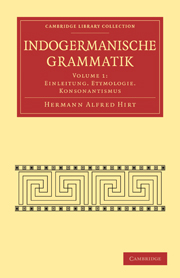Book contents
- Frontmatter
- Vorwort
- Contents
- Literaturangaben
- Verzeichnis der Abkürzungen
- Einleitung
- Erster Teil. Etymologie
- XI. Kapitel Die Lautlehre
- XII. Kapitel Grundgesetze der etymologischen Forschung
- XIII. Kapitel Die Bedeutung der Wörter
- XIV. Kapitel Verwandte und entlehnte Wörter
- XV. Kapitel Verlust von Worten
- XVI. Kapitel Etymologie und Kulturgeschichte
- Zweiter Teil. Der idg. Konsonantismus
- XVII. Kapitel Die Sonorlaute
- XVIII. Kapitel Die Zischlante
- XIX. Kapitel Idg. j und w
- XX. Kapitel Die idg. Tenues und Mediä
- XXI. Kapitel Die idg. Mediä aspiratä
- XXII. Kapitel Die Lautverschiebung
- XXIII. Kapitel Das Hauchdissimilationsgesetz im Griechischen und Indischen
- XXIV. Kapitel Die Gutturalreihen
- XXV. Kapitel Die Tenues aspiratä
- XXVI. Kapitel Sonstige Laute des Idg
- XXVII. Kapitel Konsonantenverbindungen
- XXVIII. Kapitel Die r-Verbindungen
- XXIX. Kapitel Die l-Verbindungen
- XXX. Kapitel Die n-Verbindungen
- XXXI. Kapitel Die m-Verbindungen
- XXXII. Kapitel Die w-Verbindungen
- XXXIII. Kapitel Die j-Verbindungen
- XXXIV. Kapitel Die s-Verbindungen
- XXXV. Kapitel Veränderungen des Konsonantenstandes im Idg. Schwund von Konsonanten
- XXXVI. Kapitel Konsonantenwechsel
- XXXVII. Kapitel Auslautsgesetze
- XXXVIII. Kapitel Der Anlaut
- Autorenverzeichnis
- Sachverzeichnis
- Wörterverzeichnis
XXXI. Kapitel - Die m-Verbindungen
Published online by Cambridge University Press: 05 August 2011
- Frontmatter
- Vorwort
- Contents
- Literaturangaben
- Verzeichnis der Abkürzungen
- Einleitung
- Erster Teil. Etymologie
- XI. Kapitel Die Lautlehre
- XII. Kapitel Grundgesetze der etymologischen Forschung
- XIII. Kapitel Die Bedeutung der Wörter
- XIV. Kapitel Verwandte und entlehnte Wörter
- XV. Kapitel Verlust von Worten
- XVI. Kapitel Etymologie und Kulturgeschichte
- Zweiter Teil. Der idg. Konsonantismus
- XVII. Kapitel Die Sonorlaute
- XVIII. Kapitel Die Zischlante
- XIX. Kapitel Idg. j und w
- XX. Kapitel Die idg. Tenues und Mediä
- XXI. Kapitel Die idg. Mediä aspiratä
- XXII. Kapitel Die Lautverschiebung
- XXIII. Kapitel Das Hauchdissimilationsgesetz im Griechischen und Indischen
- XXIV. Kapitel Die Gutturalreihen
- XXV. Kapitel Die Tenues aspiratä
- XXVI. Kapitel Sonstige Laute des Idg
- XXVII. Kapitel Konsonantenverbindungen
- XXVIII. Kapitel Die r-Verbindungen
- XXIX. Kapitel Die l-Verbindungen
- XXX. Kapitel Die n-Verbindungen
- XXXI. Kapitel Die m-Verbindungen
- XXXII. Kapitel Die w-Verbindungen
- XXXIII. Kapitel Die j-Verbindungen
- XXXIV. Kapitel Die s-Verbindungen
- XXXV. Kapitel Veränderungen des Konsonantenstandes im Idg. Schwund von Konsonanten
- XXXVI. Kapitel Konsonantenwechsel
- XXXVII. Kapitel Auslautsgesetze
- XXXVIII. Kapitel Der Anlaut
- Autorenverzeichnis
- Sachverzeichnis
- Wörterverzeichnis
Summary
Die Labiale + m. Die Verbindungen pm, bm, bhm sind im Anlaut unmöglich.
Im Inlaut müssen sie, da das Suffix -m sehr häufig ist, und es Basen auf, -p, -b, -bh zur Genüge gibt, nicht selten auftreten.
tm.
tm begegnet nur in gr. τμητός ‘geschnitten’ zu τέμνω ‘schneide’. Also wird t vor m geschwunden sein. Infolgedessen sleht nichts im Wege, die Basen met (1. meto) und mē, ahd. māan ‘mähen’ auf tmet, tmē zurückzuführen, vor allem da noch heute ‘schneiden’ für ‘mähen’ ganz gewöhnlich gesagt wird. Schon Brugmann, IF. 15, 73 hat meto in me + to zerlegt. tm im Inlaut begegnet in ai. ātmá m. ‘Hauch, Seele’, mit dem man d. Atem vergleicht. Dazu könnte auch ahd. muot < tmō gehören.
dm.
≪Das anlautende dm beschränkt sich nach L. Meyer, Gr. Gr. 1, 372 auf einige zu δάμνημι ‘ich bezähme’ gehörige Formen≫. Dazu δμώς ‘Sldave’, das wohl zu gr. δόμος, ‘Haus’ gehört. In den übrigen Sprachen fehlt dm. Da die Basen dem ‘bauen’ und demā ‘zähmen’, die im letzten Grunde eins sein dürften, außerordentlich verbreitet sind, so wird man unter den mit m anlautenden Wörtern, wie sohon geschehen, solche suchen dürfen, die einst mit dm anlauteten. So lat. māteria, māteriēs ‘Bauholz, Nutzholz, Stoff, Materie’, arm. mairi ‘Bauholz, Holz, überhaupt Gehölz’, nach Osthoff, Festgruß an Roth 126 f. aus dmāteries. Auch mōs ‘Sitte’ läßt sich wohl zu domus ‘Haus’ stellen.
- Type
- Chapter
- Information
- Indogermanische Grammatik , pp. 275 - 277Publisher: Cambridge University PressPrint publication year: 2009First published in: 1927



